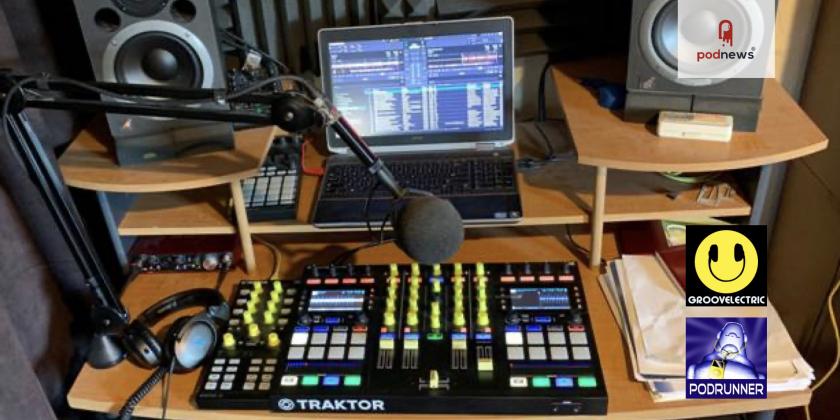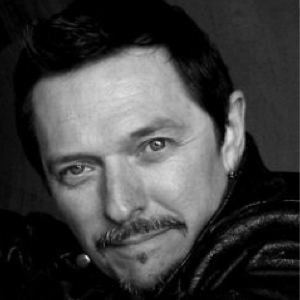
How I make... Podrunner and Groovelectric

This article is at least a year old
Since 2006 I’ve produced two music podcasts, Podrunner (workout music mixes) and Groovelectric (electronic dance music with funk roots).
Studio
I live in an open-plan home that used to be a small library, so my studio is a corner sectioned-off with sound-blocking curtains and acoustic-foam panels.
Music Mixing
I record on a Dell laptop running Windows 7 that’s been very tweaked for audio production and live performance. As a DJ, I mix studio & live using Native Instruments Traktor Pro 3; Native Instruments Kontrol S5, Kontrol X1, and Kontrol F1 controllers; and Sennheiser HD7 headphones. Post-recording I edit the mixes in Sound Forge Pro using iZotope Ozone plugins and the Waves L3 Multimaximizer.
I should point out that I do a lot of music recording and editing, and Sound Forge was designed specifically for post-production. For most podcasters, I highly recommend Hindenberg Journalist — it’s a beautifully designed, flexible, and powerful recording application.. (I keep meaning to get the version meant for audiobook recording. It ain’t cheap, but it’s incredible.)
Vocal Recording
I record each episode’s two-minute intro using Sound Forge Pro with a Shure SM7B microphone plugged into an SE Electronics DM1 Dynamite mic preamp (I recommend it over the more commonly paired Cloudlifter) and mounted on a Rode PSA-1 swing-arm; a Focusrite Scarlett 2i4 audio interface; and Ultrasone HFI-700 headphones.
Because my studio is in a high-ceilinged structure, I can’t avoid a certain amount of reverb without building a booth, so I treat my unprocessed vocal with Izotope RX7 De-Reverb, which is friggin magic. After that I process using chained Waves C1 Gate Stereo, DeEsser, DeBreath, and L3 Multimaximizer plugins with presets tweaked to suit my voice and environment. I monitor with Event Project Studio 6 studio monitors and an M-Audio BX10s subwoofer, though I don’t use them very often anymore.
Website
I have a large and evergreen inventory that needs a space-saving solution. Expandable accordions seemed to be a great option, and since WordPress was very clunky for that and I’m much more conversant with HTML than PHP, I designed and maintain both websites using Website X5 Pro. The accordions were designed using DW Accordions for Dreamweaver from Extend Studios (the app is free now!).
Newsletter
I still use Dreamweaver 8 (!) to compose and edit my Podrunner and Groovelectric newsletters. I distribute them using EasySendy Pro and an Amazon Web Services account. It’s super cheap but it’s a pain to set up. But it’s cheap. But it’s a pain. A new one goes out every time a new episode goes online. It has direct MP3 links, player links, background info, a Donate button, and whatever else I think will inform or entertain my listeners. With Groovelectric, I occasionally do exclusive mixes for newsletter subscribers.
Host
Libsyn for both podcasts, since 2006. They’ve been solid as a mountain. That said, I believe strongly in podcasters hosting their own feeds, and Podrunner and Groovelectric’s RSS feeds are on their respective websites. I code the feeds manually, because I’m dumb like that.
Artwork
I designed the Groovelectric logo after accidentally holding up a pair of headphones in front of something circular. The Podrunner logo was designed in collaboration with much-missed animator and designer Joe Riley.
Process
- Saturday: Listen to promo tracks that came in during the week.
- Sunday: Conform downloaded track filenames and metadata for easier sorting, searching, and playlisting later on. Analyze and categorize in Traktor.
- Monday: Audition tracks for the upcoming mix. If this goes fast it’s 3-4 hours to find about 20 tracks that work. If it doesn’t go fast it’s a day or two.
- Tuesday:
- Pare down the tracklist to about 12 tracks. Position and blend them until I’m happy with the fit and flow.
- Record the mix. That hour is the shortest block of the entire process, and it’s what all the rest orbits around. Also my favorite part.
- Edit the audio file in Sound Forge Pro, tweaking volume and EQ to get a more consistent level. I used to exclusively use Waves L3 Maximizer to normalize, but recently I’ve started using Izotope Ozone’s mastering suite. For consistent loudness I’m not sure if one is better, but the EQ tweaks in Ozone are a lot less work.
*Wednesday: - QA the mix as I do errands (I have a very loud and fairly nice car audio setup).
- Listen again on headphones as I compose the newsletter.
- Update the website and RSS feed.
- Write the two-minute intro in WordPerfect (screw you, MS Word)
- Record it. Even after nearly 15 years and well over a thousand episodes I’m still mic conscious, and I usually do at least three takes. I pick the best (usually the most recent), edit it, de-reverb it with Izotope RX7, then apply chained Waves plugins.
- Mix the vocal with my theme music (I composed the Podrunner and Groovelectric themes), normalize that, and paste it to the beginning of the mix. Check levels, save it as an MP3.
- Apply metadata to the episode MP3 with iTunes.
- Thursday:
- Add final info (duration & size) to the RSS feed.
- Upload the episode to Libsyn and launch it.
- Upload the updated website.
- Upload my newsletter to EasySendy and distribute
Adding it all up (and the above is by no means everything), I’d say each hour-long episode represents between about 12 hours of work. More if anything goes sideways.
































































































